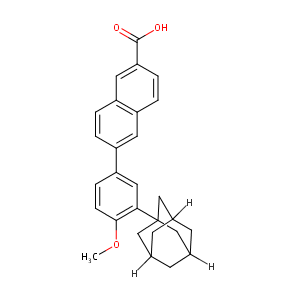Details of the Drug
General Information of Drug (ID: DMX2358)
| Drug Name |
Adapalene
|
|||||||||||||||||||
|---|---|---|---|---|---|---|---|---|---|---|---|---|---|---|---|---|---|---|---|---|
| Synonyms |
Adaferin; Adapaleno; Adapalenum; Differin; Differine; CD 271; CD271; Adaferin (TN); Adapaleno [INN-Spanish]; Adapalenum [INN-Latin]; CD-271; Differin (TN); Differin, Adapalene; KS-1196; Adapalene [USAN:BAN:INN]; Adapalene (JAN/USAN/INN); 6-(3-(1-Adamantyl)-4-methoxyphenyl)-2-naphthoic acid; 6-(3-adamantan-1-yl-4-methoxyphenyl)naphthalene-2-carboxylic acid; 6-[3-(1-adamantyl)-4-methoxyphenyl]naphthalene-2-carboxylic acid; 6-[3-(adamantan-1-yl)-4-methoxyphenyl]-2-naphthoic acid
|
|||||||||||||||||||
| Indication |
|
|||||||||||||||||||
| Therapeutic Class |
Dermatologic Agents
|
|||||||||||||||||||
| Drug Type |
Small molecular drug
|
|||||||||||||||||||
| Structure |
 |
|||||||||||||||||||
| 3D MOL | 2D MOL | |||||||||||||||||||
| #Ro5 Violations (Lipinski): 1 | Molecular Weight (mw) | 412.5 | ||||||||||||||||||
| Topological Polar Surface Area (xlogp) | 7.7 | |||||||||||||||||||
| Rotatable Bond Count (rotbonds) | 4 | |||||||||||||||||||
| Hydrogen Bond Donor Count (hbonddonor) | 1 | |||||||||||||||||||
| Hydrogen Bond Acceptor Count (hbondacc) | 3 | |||||||||||||||||||
| ADMET Property | ||||||||||||||||||||
| Chemical Identifiers |
|
|||||||||||||||||||
| Cross-matching ID | ||||||||||||||||||||
Molecular Interaction Atlas of This Drug
 Drug Therapeutic Target (DTT) |
|
||||||||||||||||||||||||||
|---|---|---|---|---|---|---|---|---|---|---|---|---|---|---|---|---|---|---|---|---|---|---|---|---|---|---|---|
| Molecular Interaction Atlas (MIA) | |||||||||||||||||||||||||||
Drug-Drug Interaction (DDI) Information of This Drug
|
Coadministration of a Drug Treating the Disease Different from Adapalene (Comorbidity)
|
|||||||||||||||||||||||||||||||||||||||||
Drug Inactive Ingredient(s) (DIG) and Formulation(s) of This Drug
References
| 1 | URL: http://www.guidetopharmacology.org Nucleic Acids Res. 2015 Oct 12. pii: gkv1037. The IUPHAR/BPS Guide to PHARMACOLOGY in 2016: towards curated quantitative interactions between 1300 protein targets and 6000 ligands. (Ligand id: 5429). | ||||
|---|---|---|---|---|---|
| 2 | Topical retinoids in acne vulgaris: update on efficacy and safety. Am J Clin Dermatol. 2008;9(6):369-81. | ||||
| 3 | BDDCS applied to over 900 drugs | ||||
| 4 | Estimating the safe starting dose in phase I clinical trials and no observed effect level based on QSAR modeling of the human maximum recommended daily dose | ||||
| 5 | A review of adapalene in the treatment of acne vulgaris. J Adolesc Health. 2008 Nov;43(5):421-4. | ||||
| 6 | Topical treatment in acne: current status and future aspects. Dermatology. 2003;206(1):29-36. | ||||
| 7 | Vitamins and cofactors: highlights of ESBOC 2009. Nat Chem Biol. 2009 Aug;5(8):530-3. | ||||
| 8 | Retinoids--which dermatological indications will benefit in the near future Skin Pharmacol Appl Skin Physiol. 2001 Sep-Oct;14(5):303-15. | ||||
| 9 | Retinoid agonist isotretinoin ameliorates obstructive renal injury. J Urol. 2003 Oct;170(4 Pt 1):1398-402. | ||||
| 10 | National Cancer Institute Drug Dictionary (drug id 39582). | ||||
| 11 | Peretinoin, an acyclic retinoid, improves the hepatic gene signature of chronic hepatitis C following curative therapy of hepatocellular carcinoma. BMC Cancer. 2013 Apr 15;13:191. | ||||
| 12 | 13-cis retinoic acid exerts its specific activity on human sebocytes through selective intracellular isomerization to all-trans retinoic acid and binding to retinoid acid receptors. J Invest Dermatol. 2000 Aug;115(2):321-7. | ||||
| 13 | Chromosomal translocation t(15;17) in human acute promyelocytic leukemia fuses RAR alpha with a novel putative transcription factor, PML. Cell. 1991 Aug 23;66(4):663-74. | ||||
| 14 | Initial clinical trial of oral TAC-101, a novel retinoic acid receptor-alpha selective retinoid, in patients with advanced cancer. J Clin Oncol. 2002 Aug 15;20(16):3522-32. | ||||
| 15 | Trusted, scientifically sound profiles of drug programs, clinical trials, safety reports, and company deals, written by scientists. Springer. 2015. Adis Insight (drug id 800027956) | ||||
| 16 | An antagonist of retinoic acid receptors more effectively inhibits growth of human prostate cancer cells than normal prostate epithelium. Br J Cancer. 2004 Aug 2;91(3):580-8. | ||||
| 17 | Blakely KM, Drucker AM, Rosen CF "Drug-induced photosensitivity-an update: Culprit drugs, prevention and management." Drug Saf 42 (2019): 827-47. [PMID: 30888626] | ||||
| 18 | Cerner Multum, Inc. "Australian Product Information.". | ||||
| 19 | Cerner Multum, Inc. "UK Summary of Product Characteristics.". | ||||
